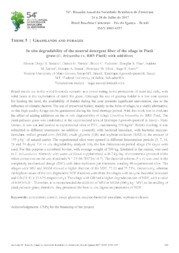In situ degradability of the neutral detergent fiber of the silage in Piatã grass (U. brizantha cv. BRS Piatã) with additives.
In situ degradability of the neutral detergent fiber of the silage in Piatã grass (U. brizantha cv. BRS Piatã) with additives.
Author(s): SEDANO, A. D. B.; PEREIRA, D. H.; PEDREIRA, B. C. e; PINA, D. S.; XAVIER, I. M.; SOUZA, H. A.; SILVA, H. M.; ASSIS, H. F.
Summary: Brazil stands out in the world livestock scenario as a power rating in the production of meat and milk, with solid bases in the exploitation of cattle the grass. Although the use of grazing fodder is a low cost system for feeding the herd, the availability of fodder during the year presents significant unevenness, due to the influence of climatic factors. The use of preserved fodder, mainly in the form of silage, is a viable alternative, so that high quality forage can be guaranteed during the food shortage period. With this work was to evaluate the effect of adding additives on the in situ degradability of silage Urochloa brizantha cv. BRS Piatã. The piatã palisade grass was established in the experimental area of Embrapa Agrossilvipastoril in Sinop - Mato Grosso, it was cut and ensiled in experimental silos of PVC, maintaining 650 kg/m3. Before ensiling, it was submitted to different treatments: no additive - (control); with bacterial inoculant; with bacterial enzymeinoculant; milled ground corn (MGM); crude glycerin (GB) and soybean molasses (MSJ) in the amount of 100 g.kg-1 of natural matter. The experimental silos were opened in different fermentation periods (3, 7, 14, 28 and 56 days). For in situ degradability analysis only the last fermentation period silage (56 days) were used. For this purpose a crossbred bovine, with average weight of 500 kg, fistulated in the rumen, was used in U. brizantha cv. Marandu with water ad libtum supplemented with 2 kg/day of concentrate (protocol of the ethics committee on the use of animals N ° 23108.701716/14-7). The factorial scheme (5 x 6) was used in the completely randomized design (DIC) with three replicates per treatment, totaling 90 experimental silos. The silages with MSJ and MGM showed a higher fraction of the NDF, 72.11 and 75.73%, respectively, whereas the highest values of the non-degradable NDF fractions were from the silages with enzyme-bacterial inoculant and GB (31.41 e 33.83% respectively). The silage with GB had a higher degradation rate of NDF, with a value of 0.0836%.h-1. Therefore, it is recommended the addition of MSJ or MGM (100 g.kg-1 MV) in the ensiling of piatã palisade grass, therefore, they presented the best in situ digestion parameters of NDF.
Publication year: 2017
Types of publication: Abstract in annals or event proceedings
Observation
Some of Embrapa's publications are published as ePub files. To read them, use or download one of the following free software options to your computer or mobile device. Android: Google Play Books; IOS: iBooks; Windows and Linux: Calibre.
Access other publications
Access the Agricultural Research Database (BDPA) to consult Embrapa's full library collection and records.
Visit Embrapa Bookstore to purchase books and other publications sold by Embrapa.

